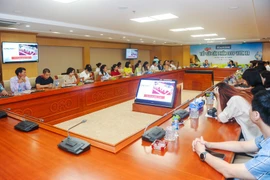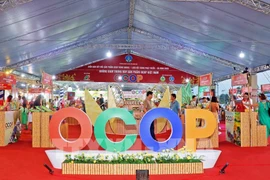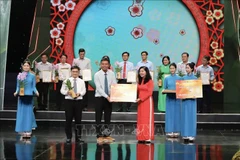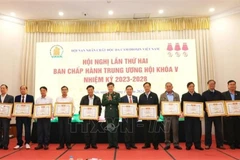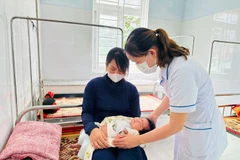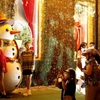An Giang (VNA) - Palm trees have been familiar to the Khmer community in the Bay Nui region of souther An Giang province for generations. Almost all Khmer families grow the trees along the borders of fields to stabilise soil and also gain economic benefit. Palm trees take about 15 years or more to bear fruit and produce sugar sap.
As legend has it, a farmer herding cattle took a noon break under a palm tree. As he dozed off, he suddenly woke up to a sweet drop falling into his mouth. Sitting up and looking around, he couldn't find the source. Curious, he climbed the tree and discovered that the drops of sweet sap were coming from a broken bud of the palm tree. He quickly took his bamboo tube to collect the sweet liquid gifted by nature and brought it home to share with his wife and children.
Since then, locals have maintained the tradition of using bamboo tubes to collect the sweet palm sap from the trees. Because it ferments quickly and becomes unusable, Khmer people devised a method to process it into wine and concentrate it into the palm sugar as we know today.
Typically, the palm sugar season runs from the 10th lunar month of one year to the 4th lunar month of the next. The Khmer in An Giang climb the palm trees and set up tools to collect the sap from the flower stalks. This sap is the raw material for making sugar.

Palm sugar is used to cook sweet soups or prepare various dishes. Its unique light sweetness enhances the flavour of meals and has soothing properties for throat ailments. The technique for making palm sugar is sophisticated, and the quality varies depending on the makers’ skills.
The furnace is built right inside the house and can use various fuels like rice husks, firewood, and coal. Rice husks are the most common due to their availability and low cost. The secret lies in monitoring the sugar boiling process; an experienced worker can adjust the furnace temperature accurately to promote optimal results. Additionally, by tasting the palm sap, the worker can determine the sugar content and calculate how much lime water to add to neutralise the acidity.
The liquid sugar is poured into a pot and heated to remove impurities from the initial processing. The temperature of the sugar should not exceed 80 degrees Celsius as higher temperatures cause caramelisation, resulting in a dark colour that diminishes the quality.
The cook must stir continuously and skim off the foam and impurities until the steam evaporates and the sugar thickens, at which point they can stop. The liquid sugar is then poured into molds with cylindrical shapes.
As the sugar cools naturally, it crystallises into fine crystals. Tasting a piece of sugar reveals a sweet, rich flavour that melts in the mouth. For tourists, a taste of this raw cooked sugar form creates an unforgettable experience of a product made from natural sources in the surrounding community.
Moreover, all parts of the palm tree are utilised by the locals. Specially, the trunks are used to make furniture, the leaves for roofing, and the fruit and pulp for beverages. The sap can be fermented to make palm wine called “arac” or concentrated to produce palm sugar.

The Minister of Culture, Sports, and Tourism issued the decision to recognise the palm sugar-making craft of the Khmer in Tinh Bien district and Tri Ton township as part of the national intangible cultural heritage. Speaking at the ceremony to announce the decision on December 27, Deputy Director of the An Giang Department of Culture, Sports, and Tourism Truong Ba Trang congratulated the local government, artisans, and Khmer community in Tinh Bien and Tri Ton for receiving this special honour.
He also stated that the department will work with local authorities to develop a plan for preserving and promoting the palm sugar-making craft between 2025 and 2030.
Trang said that the palm tree not only provides economic value for the people but also carries cultural significance, particularly for the Khmer community, contributing to the preservation and promotion of traditional local crafts as a driver of the local economy.

Currently, the palm tree is not only famous for its sweet sap used to make sugar but has also led to the creation of many products. These include palm wine and fresh juice, sweet soup, jelly, leaf paintings, cakes, and palm color syrup. Each of these unique products are supported to develop into One Commune, One Product (OCOP) items.
According to statistics from Tinh Bien, there are 305 palm sugar production establishments in the township, employing 780 workers directly, with an annual output of 3,138 tonnes.
Trang said that he hopes governments and relevant agencies at all levels will issue policies, provide vocational training, connect to markets, and promote tourism for craft villages to help locals sustain their livelihoods.
Besides, the Khmer community must preserve traditional crafts, expand marketing channels, and coordinate with travel agencies to invite visitors to explore the cultural value./.

